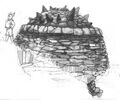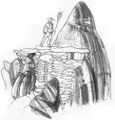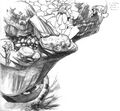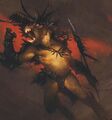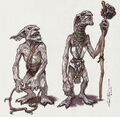Goblin
| Goblin | |
|---|---|
| Creature Type | |
| (Subtype for creature/kindred cards) | |
| Introduced | Alpha |
| Last used | Characteristic species |
| Beeble Scale | 1[1] |
| Scryfall Statistics | |
Goblins is a creature type used for cards that depict a race of diminutive humanoids, frequently encountered in underground warrens in mountain areas.
Storyline
Goblins are passionate and chaotic, which causes many to perceive them as having low intelligence.[2] They often demonstrate a certain ingenuity and affinity for artifacts. Like elves, goblins seem to be abundant in the Multiverse, to the extent that their absence is more notable than their presence: the only planes that appear to lack native goblins are Amonkhet, Capenna, Ikoria, Kaldheim, Ulgrotha, Innistrad, Theros, and Kaladesh. On most planes, they are red-aligned, and they are the characteristic species for that color.[3][4] However, they have appeared in all five colors, notably among the boggarts of Lorwyn-Shadowmoor[5] and as Izzet and Boros guild members on Ravnica. They vary widely in appearance, but generally share a short stature.[2]
Cards with the creature type Goblin first appeared in Alpha, on Goblin Balloon Brigade, Goblin King, and Mons's Goblin Raiders.
Alara
The only goblins known to inhabit the five sundered planes of Alara are found in the inhospitable world of Jund. They are small, barbaric creatures that lack the whimsical side of most other goblins. In Jund's rigid pecking order/food chain, goblins are the least powerful sentient race; they are frequently preyed upon by the plane's equally barbaric humans and viashino and survive chiefly through their great numbers. They worship the majestic dragons that rule Jund's smog-choked skies and consider it an honor to be devoured by the great beasts.[6] Most goblins live in cairnlike "shelter stones" that are heaped up to keep off the worst predator attacks. Scavengers who pick the bones of old kills, goblins also eat insects and worms, and gather the roots and tough fruit of the sparse vegetation that grows on mountainsides and plateaus.
Jund goblins are bestial in appearance, with rodent-like features similar to the nezumi of Kamigawa. They have small red eyes, elongated muzzles with powerful incisors, bent legs like a rat, and short tails; they are covered in short brown hair.[6] Most goblins are spindly in build, but stronger than they appear and very fast. They can wriggle into spaces a snake would have second thoughts about. The word for squirming into a tight crack — a goblin’s preferred escape tactic — is the somewhat poetic phrase plikintok agat, or "wearing a garment of rock." Jund goblins wear only the skins and bones of creatures they kill. They wield primitive weapons made of their ancestors’ bones, especially femurs and ribs, and a leader carries a mace crafted from the skull of his or her predecessor.
Starving groups of goblins will sometimes organize raids on the more verdant lands below them.[6] These raids are usually a disaster, however. Raiders are picked off one-by-one by predators, carnivorous plants, or their own incompetence — or the entire party is devoured by a fire elemental or some other monstrosity. The goal of such raids is for at least one goblin to return with food for at least two. The unspoken truth about these raids is that they're a form of population control.
Arcavios
Not much is known about goblins in Arcavios aside from the fact they do exist. What is known is that it's heavily implied they're not very smart, as one goblin tries to keep applying to Strixhaven by shouting "Apply!" at the administrators rather than showcasing their talents and intelligence.
Bablovia
The Goblin Explosioneers of Bablovia are steamfloggers and tinkerers that experiment with lots of crazy ideas, many of which explode.[7] They breed fast enough to not wipe out their race.
Dominaria
Dominarian goblins are known for their tenacity in battle, low intellect, and high incidence of accidental death. Their diet consists mostly of slugs, grubs, and snails.[8]
Goblins live nearly anywhere on Dominaria where suitable deserts and mountains can be found. Among Argivian scholars, it was a documented fact that the further one would get from the site of the Brothers' War (on the shattered continent of Terisiare), the more feral, beast-like and generally stupid the local goblins tended to become.[9] Below are a few of the main goblin nations and subraces on Dominaria.
Aerona
Not much is known about the native goblins of Aerona, aside from their general ubiquitousness. Many were found in the Ironclaw Mountains and Oneah, and joined forces with their one-time human enemies during the Phyrexian Invasion of Dominaria and were trained as soldiers.
Rundvelt Goblins
One of the most notorious tribes is the Rundvelt goblins, who mastered the use of Rock Sleds, and siege equipment, and even developed a societal structure. Though the intricate dynamics of their affairs are often confused with anarchy, leadership among them can appear sporadically and violently. One such leader was Pashalik Mons, whose time brought previously unrivaled unity and efficacy to the hordes he led.
Caliman
Goblins in Caliman have the usual green skin color and small size, but have longer noses and ears than other goblins. They use firearms and possess more advanced weapons than other goblins because of the higher levels of technology available on Caliman. They build pillbox-shaped homes to avoid the plentiful dragons that inhabit the island.
Jamuraa
Jamuraan goblins are a fairly typical breed. Some have a certain affinity with artifacts and are more mischievous than malicious. Jamuraan goblins tend to have very long, swept-back ears but otherwise, vary widely in appearance.
Otaria
The goblins of Otaria inhabit the Skirk Ridge in the southern Pardic Mountains,[10] and as such are called Skirk for short. They are enthusiastically enamored with fire and explosions, often to their detriment. They are even more reckless than most other goblins, if possible. Some goblins found their way into the Cabal as traitors or, worse, zombie slaves. The Skirk made their homes in elaborate networks of cliffside tunnels, building rickety rope bridges to navigate their environment. After the Phyrexian Invasion, they were joined by many goblin refugees from elsewhere in Dominaria seeking a new home.[11]
Otarian goblins tend to be very short and squat, with long bulbous noses and flaring bat-like ears.
Mutant Goblins
Due to the influence of the Mirari, many Skirk were mutated, becoming even more ferocious and destructive. Mutant goblins grew fang-like teeth and bony claws. Many became huge, unstable hulks, while others developed innate powers of destructive magic.
Razorfins
Razorfins are a bizarre crossbreed of goblins and merfolk found beneath the seas of Dominaria. All that is known about them is that they were the result of mutations caused by the Rathi Overlay.
Sarpadia
Goblins were one of the plagues faced by the empires of Sarpadia. They and the Sarpadian orcs destroyed the dwarven nations of the continent. Both eventually faced the Icatians, but with less success. They were eventually wiped out by the thrulls.
Sarpadian goblins came in a very wide variety of forms, with no apparent morphological standard. They were known for their war kites[12], devastating grenades, and terrifying war drums.
Shiv
During the time of the Thran, the goblins of Shiv worked with the viashino in the Mana Rig. After the Thran Civil War, the purpose of the Mana Rig was forgotten, though both races still felt attached to the place and each saw it as their holy place. This led to frequent fights until Urza came. The goblins eventually grew to work alongside their viashino counterparts.
While most Shivan goblins have wedge-shaped ears that stick outwards from their heads and green skin like other goblins, three clans of Shivan goblins have different colored skin: Goblins of the Destrou clan have red-scaled skin, the Grabbit clan goblins have gray skin, and the Tristou clan features silver-scaled goblins.[13] Due to their breeding by the Thran, many are highly talented artificers. Moggs from Rath were introduced into the Goblin population around 4205 AR, causing some evolutionary changes. Despite being poorly regarded for much of Shiv's history, the Shivan Nation now regards them as equals alongside the Ghitu, Dragons, and Viashino.[14]
Okks
Some Shivan goblins, known as okks, were possessed of uncommonly great size and strength, yet possessed typical goblin intelligence and cowardice. It is unknown if okks were a separate species of goblin or simply mutants.
Terisiare
Goblins proliferated on the continent of Terisiare as far back as the time of the Thran. At one time relatively sophisticated slaves of the Thran, they made useful servants for artificers during the time of the Brothers' War, but by the advent of the Dark Age had descended into utter barbarism and posed a constant threat to the humans of the continent; aside from the despotic Church of Tal, the goblins posed the greatest threat to civilization during this period.
The goblins, as well as their orcish allies, were hunted mercilessly by the Knights of Thorn and dwindled greatly as the Ice Age dawned. Some were enslaved as scouts by the humans of Kjeldor and Balduvia, while others were altered by the snow magic of the cryomancer Heidar, but with the coming of the Thaw and the drowning of much of the continent, the goblins became increasingly rare. It is unknown if any goblins survived in the Terisian Isles by the Modern Age. Terisian goblins differed little in appearance from their relatives elsewhere.
Goblins of the Flarg
The Goblins of the Flarg were a major threat during the Dark Age on Terisiare, and often made war with both the humans and dwarves of the continent. They lived somewhere to the north of Giva Province, the birthplace of Jodah. Especially warlike, they were in constant strife with the other peoples. At the Battle of Pitdown, they made a surprise attack on the fighting forces of Ghed and Alsoor, which Jodah was a part of. Flarg Goblins were locked in a heated battle with the Knights of Thorn and were eventually eradicated by them at the end of the Ice Age with the help of Lord Ith.
Marsh Goblins
The Marsh Goblins lived in the swamps of Terisiare during the Dark Age and were shunned even by other goblins for their foul practices.[15] They were hairless, heavyset, and pale-skinned, with floppy ears and small vestigial tails, and seem to have never taken to wearing clothes. Some marsh goblins were present at the Battle of Pitdown.
Scarwood Goblins
Scarwood Goblins were found on Terisiare during the Dark Age. They were larger and more powerful than other Terisian goblins (though not as large as orcs), with sickly light-green skin and large, glowing orange eyes.[16] Found only in isolated pockets of large forests like Scarwood, some of these goblins nonetheless participated in the Battle of Pitdown.
Post-Apocalyptic Goblins
After the Phyrexian Invasion and Karona's cataclysm, Dominaria's environment became increasingly hostile, and the world's goblins (including the moggs, who had become naturalized inhabitants of Dominaria) became more feral than ever. Due to the acrid air in their mountain homes, the skin on most goblins' faces wore away, giving them a skull-like visage and causing catarrhs to form over their eyes, and the lack of nourishing food gave them an unhealthily bony appearance.[17] With the resolution of the Time Spiral crisis, the goblins of Dominaria started on the road back to recovery, with some evolutionary changes due to the introduction of the Moggs.[14]
Eldraine
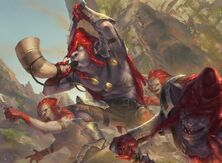
Like in Shadowmoor, the goblins of Eldraine are known as redcaps.[18] They take their name from their red hair, said to be stained with the blood of their enemies.[2] They are mischievous agents of chaos, standing about as tall as a barrel, with distorted features. Redcaps fight without any sense of honor or fair play, specializing in cowardly sneak attacks and ambushes. Within the border of the Realm, redcaps have been hunted ruthlessly and their burrows have been burned out. However, they still thrive in the Wilds, often raiding villages across the Boundary Lands before retreating back to the Wilds.[19] Redcaps are known to smear their swords with pussflower juice, to poison their prey if they don't kill them outright.
Eldraine's dwarves have a longstanding feud with its redcaps, caused long ago by a dispute over a spoon, though it had raged for so long that no one could quite recall how it started.[20] The feud boiled over in a massive food fight known as the Assault on Delverhaugh.
Fiora
The Goblins of Fiora are generally looked down upon, but some have managed to insert themselves into the structures of the High City. Most notably, figures like Daretti managed to attend the Academy despite specieism from some members, and the goblin Grenzo managed to secure himself a position as Dungeon Keeper of Brago.
After Brago's death, violent Goblin gangs stalked the city, stirring up unrest and plundering.
Ixalan

Two distinct varieties goblins are native to the plane of Ixalan: a monkey-like race native to the surface continent of Ixalan, and a translucent race known as Deep Goblins native to the plane's caverns.
The surface variety of goblins resemble small monkeys. Uniquely, they also have long, prehensile tails. Their curiosity drew them to the Brazen Coalition when the pirates first arrived on the Sun Empire's shores around 98 BD. Though they still thrive in jungle colonies, goblins are commonly seen perched on gunwales and clambering up masts of sleek pirate ships.[21] For better or worse, many goblins are also incorrigible pranksters, and they often have a hard time determining when a prank is inappropriate, is poorly timed or has gone too far.[22]
The Deep Goblins of the plane's caverns are small, hairless, pale, and translucent.[23][24][25] Sturdy creatures, they are adept at navigating dark, claustrophobic corridors.[26] Some Deep goblins have an esca, a small bioluminescent organ that protrudes from their brow, like a hanging lantern. These are prized among goblinkind for their beauty and rarity.
Deep goblins have a long history in the caverns but little recorded history as they have never banded together in a massive, centralized society in the way that the other denizens of the caverns have.[26] Deep goblins have existed alongside these cultures through their rises and falls, safe in their warrens and always willing to engage with the dominant power. Survival for Deep goblins is the marker of success. Unaffected by the New Phyrexian Invasion, the Deep goblins of Ixalan now face their first existential cultural crisis, prompted by increasing activity in the caverns: whether to integrate with the jaguarfolk against the surface invaders and the mycoids or to remain independent.
This political stratification has led to a fracturing of Deep goblin culture: independent goblins have no written language, where mercenary goblins have adopted a dialect of the jaguarfolk script.[26] Deep goblins have a rich oral, mystic, and storytelling tradition. Without the presence of a sun and its ensuing day-night cycle, Deep goblins have a less rigid and linear conception of time: thus, there is one age and one everlasting day, with primacy given to moments and cycles.
Both independent and integrated goblin settlements are organized in hive-like warrens built from baked mud and clay.[26] Independent Deep goblin settlements are typically older, larger, and more populated than those occupied by integrated Deep goblins. Deep Goblins appear to have some ability to use Cosmium, albeit not to the same extent as the Oltec.
The deep goblins were inspired in part by Tzitzimimeh, skeletal female deities who wore skirts and were fated to devour humanity.[27]
Kamigawa
Akki (AHK-kee; lit. "Little monsters", cards)[28] are goblins that inhabit Kamigawa's mountains.[29] They are highly territorial and obsessed with fire and mischief. Few visit Sokenzan because of their presence here, along with the ogres. A few akki joined forces with the ronin of the mountains.
Akki are short and mud-brown in color, with beady eyes, long pointed noses, four-fingered hands, and three-fingered toes with long claws, short horns sticking out from their brows, and no external ears. Akki have small, wiry bodies, but their backs are protected by large turtle-like shells covered in short spikes; these shells evolved over the years as akki pranks got more and more self-destructive.
The goblins worship the Patron of the Akki, a huge, worm-like kami with a rocky body and a head like an akki.[30]
Akki strongly resemble the Kappa, another race endemic to the plane. However, they are turtles instead of goblins.
Kylem
The long-eared goblins of Kylem are an excitable race and some of the most passionate fans of martial magic. Their skin is greenish-grey.[31]
Lorwyn-Shadowmoor
The dual plane of Lorwyn-Shadowmoor has a highly diverse population of goblins. Lorwyn's boggarts are the plane's only subrace, but come in a wide array of shapes and forms; Shadowmoor, on the other hand, has no fewer than five separate subraces, including the boggarts, the redcaps, the spriggans, the hobgoblins, and the stream hoppers.
Boggarts
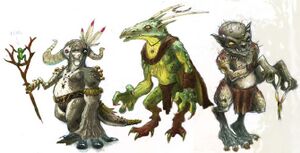
Boggarts have a greater diversity of morphology than other planes' races and sub-clans of goblins. Some of them have curving horns, others have stubby ones or none at all. Some of them have long snouts or goat-like muzzles. Some have broad, floppy ears; some have sharp points. Their skin varies from green to blue to beige to purple to red.[32] Their teeth are magical and can imbue curses on bite victims.[33]
Lorwyn Boggarts

In the plane of Lorwyn, boggarts are one of the plane's eight tribes of sentient humanoids.[34][35] They live predominantly in the sunlit bogs and craggy hills of the idyllic plane. Boggarts are incredibly mischievous, but not evildoers.[36] Boggarts are selfish creatures driven by hedonism and the desire for self-satisfaction,[37] though to keep themselves from devolving into utter anarchy the race has one universal rule: That no object or sensation shall be hoarded by an individual boggart upon pain of exile. Boggarts experience the world primarily through the sense of touch.[38] Boggarts' delight in new textures gives rise to their rampant kleptomania.
Boggarts collectors of novel sensations.[35][39] While they aren't considered particularly intelligent, they are extremely "perceptive", in that they perceive a lot.[32] When it comes to arming themselves, they improvise what they can't steal.[40] About the only law in boggart culture is the pressure to share new sensations with others of their kind.[38] A boggart that refuses to share — a hoarder — will be cast out of boggart society for the sin of keeping a new treasure to themselves. Since boggarts are so social and convivial among their own, exile is considered a terrible sentence.[32][41]
Lorwyn boggarts' magical expressions are ritualistic and organized. Rituals are accompanied by the recitation of a parable or limerick and include several convoluted and arbitrary steps. A famous example is the Boon of the Spider, consisting of the following: first capture a spider and whisper it a story under the new moon, then peel off its legs and insert the body into a hollowed acorn along with a drop of your blood, then wear the acorn around your neck for protection from hexes.[35]
Boggarts are highly fertile and believe in reincarnation; they have no problem casually killing fellow boggarts since they'll be reborn in a matter of days or even hours. Magic builds naturally in a boggart's body. The older a boggart is, the more magic accumulates in their body, and the eldest boggarts are also the most powerful. When a boggart dies, their bodies are placed in a swamp where they integrate with the ecosystem. These locations are highly magical, as are the flora and fauna that live within them. Resources gathered from swamps are made into foci for their magic. These can include bones of relatives, the turtle shell of a deceased familiar, or even a particularly "cool" stick.[35]
Elves frequently and cruelly slaughter boggarts for sport, considering them "eyeblights". The boggart population was heavily culled, with some communities dwindling to extinction between the Age of Oona and the New Phyrexian Invasion. This led to the splintering of the remaining communities and the end of the boggarts' feasts and oral traditions. Following the invasion, a renaissance of boggart culture brought back feasts, oral tradition, and brought the introduction of a pictographic language.[35]
Boggarts organize themselves into loose clans called warrens led by nominal leaders called Aunties.[38] The Auntie is usually the oldest boggart and therefore most magically potent boggart in the warren and is usually female (some are male, but are still called "Auntie"). The Auntie knows many tales and fables that they tell to educate their warren, pass on crucial boggart teachings, and adjudicate disputes. The most famous Auntie fables are about Auntie Grub, a folk hero to the boggarts, and probably a real ancestor. Auntie Grub's tales are particularly helpful for informing young boggarts about racial enemies, dangerous predators, poisonous plants, fungi, and the like.[32] Significant warrens include:
- Stinkdrinker warren, known for its stockpile of stolen goods and its boggarts' penchant for sneaking past even giants to steal their prizes.
- Squeaking Pie warren, known for its culinary adventurousness. Boggarts from other warrens often claim Squeaking Pie lineage so they can attend their Footbottom Feasts, which are widely thought to have the tastiest food. The warren's recipes are its most prized possessions, and its boggarts will go to any lengths to find bizarre new recipes and ingredients. The warren is led by Auntie Jowl, who raises the mice that often end up in the warren's famous savory pies.[42]
- Mudbutton warren, a particularly chaotic and loud warren that appreciates a good party — even if comes at the expense of a few of their members
- Frogtosser warren, a group of boggarts so emotionally changeable that the other warrens think them insane.[32]
Shadowmoor Boggarts
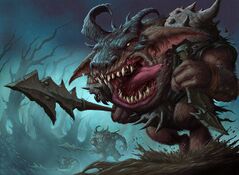
After the Great Aurora transformed Lorwyn into Shadowmoor, the boggarts changed from troublesome tricksters to animalistic marauders.[43] The boggarts of Shadowmoor are not malicious but still highly dangerous. They live to eat and will consume anything they come across, organic or not. They are little more than beasts, and their language is rudimentary at best.
Shadowmoor boggarts come together in loose packs called gangs. Known boggart gangs include the Mudbrawler, the Tattermunge, the Scuzzback, the Bloodwort, and the Boartusk. They roam Shadowmoor's mountains and forests in search of food to sate their hunger. No Shadowmoor boggart's warren has ever survived more than a generation.[35]
Boggarts wear piecemeal armor scavenged from other races, sometimes nailed to their very bodies. Like their Lorwyn counterparts, they come in a wide variety of shapes and sizes but are uniformly more feral and sinister in appearance. Aunties in Shadowmoor wander the lands, greeting those they meet with arbitrary tests, boons, or even curses.[35]
In Shadowmoor, the magic that accumulates in boggarts' bodies is chaotic and primal. The more of it they have, the more volatile they become. In their communities, the deceased are wholly cannibalized for their magic. Shadowmoor boggarts tend to practice cursecasting, often with gruesome components and methods. For example, the enactment of a curse might involve steps such as sticking porcupine quills into the heart of a goat or cooking the intestines of a toad that swallowed its own young.[35]
Hobgoblins
Also known simply as "hobs", hobgoblins appear only in Shadowmoor.[44] They are more civilized than most goblins, living in hillside cottages and dressing in clean clothes in the manner of kithkin, though like most of their kind they can be very fierce if provoked. Hobgoblins never turn down a fight, defending their homes with modified farm implements like trowel-daggers and pitchforks.[45] Some hobgoblins take to the skies mounted on giant cicadas.
Hobgoblins look like the goblins of most other worlds, but with yellowish skin, ruddy hair, and a well-groomed appearance.
Redcaps
Redcaps were among the creatures that emerged in Shadowmoor after the Great Aurora; they have no presence in Lorwyn.[46] Unlike boggarts, redcaps are actively malicious and homicidal. Their name comes from their habit of dying their caps red with the blood of their victims.
Redcaps are small in size, with pale skin, long noses, and huge eyes. They have only three digits on their hands and feet with only two toes.
Spriggans
Like redcaps and hobs, spriggans exist solely in Shadowmoor, not in Lorwyn. Spriggans are small creatures with yellow-orange skin and pointed ears and noses. They possess the power to grow to gigantic sizes. Unlike most goblins, spriggans are forest-dwellers; they are aligned with green, not red. Like boggarts, they are motivated primarily by hunger.
Stream Hoppers
Little is known of stream hoppers save that they were Lorwyn boggarts that were mutated by the Great Aurora into bizarre creatures with purple skin and only one eye, one arm, and one leg. They live near streams and cascades in Shadowmoor's jagged hills and are capable of leaping great distances.
Mercadia
Kyren
The Kyren were the ruling class in Mercadia City and had total control over the figurehead ruler, the Magistrate. They are the descendants of a group of Goblins from Dominaria during the time of the Thran who were left in Mercadia to watch over and protect the Thran council members when Rebbec and Dyfed left them there, but over time the humans became more and more decadent, while the goblins took over more of their responsibilities and sank into corruption, becoming allies with Phyrexia and Rath. However, during the Skyship Weatherlight's flight from the city, the dragon engine Ramos intercepted Volrath's ship, Recreant, and destroyed the vessel. A revolution was then triggered that swept the city.
Kyren are taller, slimmer, more attractive, and more intelligent (though not necessarily wiser) than other goblins. They are cowardly and often sadistic. They favor elaborate dresses and subtle weapons like daggers and blowguns.
Centuries after the Weatherlight arrived on Mercadia, the Dominarian goblin Squee would come to be regarded as a cultural hero of the Kyren, with many striving to model themselves on his supposed valor.
Mirrodin/New Phyrexia
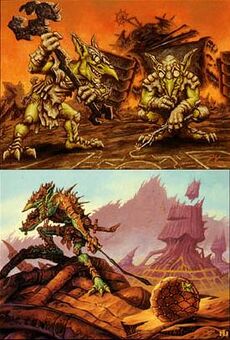
The Goblins of the Oxidda Chain, like all other creatures on Mirrodin, had patches of metal growing on their skin. Mirrodin goblins also had flat heads with swept-back, sharply-pointed ears, four-fingered hands, and three-toed feet with large claws. They see the red end of the visual spectrum strongest, even into the infrared range. They seem to have had a considerable talent for artifice.[47] Goblin social structure on Mirrodin is largely chaotic, but the priesthood has significant power. This generally involves ranting, which goblins are still likely to ignore, but a priesthood backed up by powerful and ancient machinery gets listened to rather more. The priests mostly focus on fertility and offerings of metal, which inspire raids. They are also responsible for the rites concerning the Steel Mother, the head of their pantheon of higher entities represented by the five mana suns.[48][49]
Krark-Clan
The Krark Clan is named after its founder Krark. They are mostly outcasts among the Oxidda goblins. Krark was a goblin who, legend states, found a way into the depths of Mirrodin and found another world there. Kuldotha, the Great Furnace, was a sacred location to the Krark-Clan.
Squealstokes
Compleated goblins in the service of Urabrask, squealstokes have gleefully seized the task of stoking the furnace fires both at Kuldotha and within the furnace layer. They frantically race about, building spiny contraptions to fan the flames. They sometimes fuel the furnace with a little too much zeal, occasionally throwing each other into the furnaces or anything else that happens to be lying or scurrying around. If their efforts fall short, they will throw themselves into the furnace, achieving the dual purpose of feeding the fires and avoiding more painful punishment at the hands of their overlords.[50]
Rath
Moggs
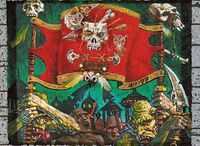
Moggs are goblin hybrids amongst the largest and most savage forms of goblins.[51] Bred mostly from goblins for nothing but battle by the evincars of Rath, they have hulking muscular bodies, sloping foreheads, and razor-sharp teeth and claws capable of eviscerating their opponents.[52] They also have the innate ability to sniff out artifacts, bred into them to aid in the acquisition of the Legacy. Moggs are probably the least intelligent type of goblin, blindly following orders even if they involve near-certain death. They were used by the Stronghold as soldiers for the Phyrexian Invasion, but after the war the few surviving moggs found freedom.
Ravnica
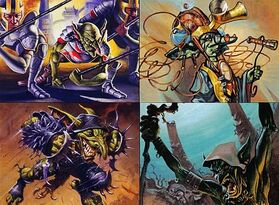
Goblins proliferate on the city plane of Ravnica, filling various functions within the guilds they populate. In the Boros Legion, they are expendable soldiers. The Izzet League uses goblins as servants and experiments. Within the Gruul Clans and Cult of Rakdos, goblins are very much like they are on most other planes: Angry and violent. Though some goblins find positions of respect within their guilds, they remain much put upon by their neighbors, and most Ravnicans regard them as little better than beasts or simpletons.
Ravnican goblins are short and green-skinned like their Dominarian counterparts, but have large, distinctive bat-like ears and long, thin noses. They seem to organize themselves according to clans, two of which are known by name: The Izzet and the Krokt.
Boros Goblins
The goblins of the Boros Legion are treated as low-level troops. Though they are equipped with the same quality weapons and armor as their troopmates, their fellow soldiers seem to regard them as little more than trained animals.
Izzet Goblins
These folk are so named because, in pre-Guildpact days, their entire tribe joined the Izzet League, either because they were bought out, they lost a wager, or because they owed the Magewrights some favor or another — the exact details are unknown. In any case, they are common servants of high-up mages of the Izzet and sometimes find lasting success within the guild. They are well known for gambling and are quintessential members of the guild in that they love to learn on impulse. Some Izzet goblins even become wizards themselves.
According to legend, the City of Ravnica (the central metropolis) had been meticulously designed with Izzet precision after the signing of the Guildpact as a gift to the other guilds. The city had also been a secret offering to Niv-Mizzet that would have created a city-sized power sigil giving the Magewrights ultimate control over the plane. Izzet goblins supposedly fumbled the design just enough to prevent the sigil from working as intended. Goblins in the old days had been a bit more rebellious and only wanted to show off to the boss, which did make an impression. The cleverness of the ancient goblins impressed the magelords enough that the Izzet League purchased the entire tribe outright.[53]
Gruul Goblins
Only among the Gruul Clans, their fellow outcasts among the folk of Ravnica, do goblins find much respect. The clans of the Gruul are multiracial, and goblins can be found in any of them. Gruul goblins tend to be berserkers or shamans. When a battle fury takes hold of a Gruul raiding group, it typically starts with the goblins.[54]
Krokt Clan
The Krokt Clan is named after Krokt, the goblin god of bad luck. They are the goblins most affiliated with the Cult of Rakdos. Krokt goblins are bloodthirsty and violent; they often dress in spike-covered armor called "kill-suits" and hurl themselves at their enemies with no thought to self-preservation.
Tarkir
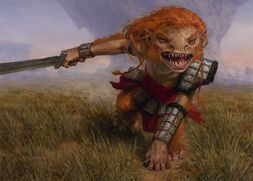
On Tarkir, there are two distinct types of goblins, Mardu and Temur.[55][56] The Mardu goblins are dangerous, tenacious fighters. They live among the humans and orcs of the clan but are generally ignored. In a fight, they often cling to the backs of mounted warriors, hopping from one rider to another. The Mardu goblins' fur colors and skin tones can vary.
The Temur goblins have evolved to adapt to the cold and usually have white fur, although the skin tones can vary. They run in packs and are barely sapient, eating whatever they can get their claws on. They scavenge when they can but aren't above dragging down large prey (usually with significant losses) when the opportunity arises.
Zendikar
A typical Zendikari goblin stands between three-and-a-half and five feet tall with a slender, elongated build. Their arms are unusually long and spindly, making them adept at climbing. Through a diet of a mineral named Grit, their skin develops a stony texture, ranging from brownish red to moss green. The older a goblin gets, the more grey his skin becomes. Their ears are large and swept back, their eyes are red, and many sport heavy bone protrusions on their spines and elbows. Males have similar growths on their chin and females on their foreheads.[57]
Apart from the usual warriors,[58] Zendikari goblins appear as traders, scouts, and aspiring beastmasters. Known clans are the Grotag, the Lavasteps and the Tuktuk.[57][59]
Goblin leadership is meritocratic and based on practical survival knowledge. The leader of a goblin tribe is therefore determined by who can retrieve the most interesting or powerful object from a ruined site. Goblins carry their most impressive prize with them as a talisman, and a goblin that hasn't yet retrieved an interesting relic from ruin or wilderness locale is not considered a full member of the tribe. Cowardly goblins are known to enable their tribe members, embellishing simple rocks as powerful artifacts.[57]
Much of Zendikari goblin society is centered around the role of the shaman, and some goblin shamans intentionally breathe Zendikar's volcanic gases. Great, chaotic magical energy is trapped in volcanic calderas, and as such, the gases often imbue the shaman with temporary magical power or visions. These "gas-talkers" are revered, but often from a safe distance.[57]
The fissure goblins of Ondu's Makindi Trenches live in the small, tight fissures between boulders and converging crags. Due to their knowledge of the area's geology, their warriors are often hired as climbing guides, while their shamans are consulted as oracles of earthquakes and gravity shifts.[57]
The goblins of Beyeen are experts at finding ore, obsidian, and gems. They keep the volcanic forces of the island appeased with sacrifices of fruit and gemstones, but still fall prey to most of the predators in their environment. Though their culture appears simple to outsiders, the Beyeen goblins have a deep dynastic history tracing back generations. Their history is recorded in swirling colors on a miles-long cave mural, called the Beyeen Vein, in the tunnels under Valakut.[57]
Goblins that explore the Singing City in Murasa inevitably go "song-mad." These goblins are banished from their tribes to stumble about the Singing City, absently crooning its song. Left in the City, they are harmless and eventually waste away, but removing a song-mad goblin far enough that it can't hear the City's singing drives it into a frenzy. Goblin tribes at war with one another often sweep the City to gather as many of the song-mad as they can. They then strap blades to them and set them loose upon the enemy.[57]
Tuktuk
Around 4507 AR, the Tuktuk tribe gained a new leader when the goblin explorer Tuktuk returned in the form of a magical replica golem. Thanks to Tuktuk's knowledge of ruin sites, Tuktuk shamans are much more adept at using relics than those of other tribes.[57] Before the Battle for Zendikar, Zada ate Tuktuk and subsumed his leadership of the tribe.[60]
Lavastep
The most industrious and warlike of the goblin tribes, the Lavastep tribe of Akoum frequently attack nearby kor, elf, and human settlements. Lavasteps ingest much more grit than the other tribes, and a typical Lavastep goblin's appearance will be quite wrinkled and gray. Also more religious than most other goblins on Zendikar, the Lavasteps worship the fires beneath the earth. Believing them sentient, Lavastep priests and prophets inhale vapors to discern their messages.[61] Due to ritual burning and scarification, most Lavasteps are extremely tolerant to heat and almost incapable of feeling pain. Though most goblins see well in the dark, many Lavastep explorers bring an ever-burning lantern with them as a religious token.[57]
The Lavasteps were hit hard by the emergence of the Eldrazi and sought shelter in the deepest parts of Akoum. They now live as far underground as possible, following strange magical emanations they call the "Stonesong", which are produced by the Eldrazi of Kozilek. Perhaps warped by these energies, these Dark-dwellers have adapted quickly to the lightless conditions and have become sightless and pale, sporting enlarged ears for echolocation.[62]
Grotag
The cleverest of Zendikar's goblin tribes, the Grotag of Bala Ged are smaller and weaker than their cousins, with larger hands and feet. Thanks in part to a natural empathy for the plane's beasts, the Grotag are the only Zendikari goblins to have successfully domesticated animals - namely the lagac and the ventcrawler. On very rare occasions, Grotag have been known to tame other animals, such as drakes or hydras, often to disastrous ends.[57]
The Grotag are also the least insular of Zendikar's goblins, often trading with the plane's other races. Some members of the tribe even live among other races. These goblins are known as "bounders" because they need to run to catch up to their traveling companions.[57] During the eldrazi's return, a number of Grotag goblins went missing in the area around Tal Terig, leading the tribe to establish a militia.[61]
Notable goblins
- Ardoz
- Egg Sucker
- Glosstongue Crackcrest
- Ib Halfheart
- Terd
- Pashalik Mons
- Rhirhok
- Rulik Mons, Warren Chief
- Squee
- Tlik
- Toggo
- Babolax
- Bogo Sternwhistle
- Crixizix
- Grangle
- Kaluzax
- Kreat
- Krenko
- Maree
- Mizzix
- Shattergang Brothers
- Skorik Boulder Tooth
- Skreeg
- Skrygix
- Squelch
- Varryvort
- Vazozav
- Unknown
Creature type updates
- Goblin King was a separate creature type in Limited Edition Alpha before being replaced by Lord in Unlimited Edition.
- In the Grand Creature Type Update the creature type Rock Sled (Goblin Rock Sled) was changed into Goblin and Goblin King was updated to be a Goblin as Lord became obsolete.
Tribal type
Lorwyn block featured five tribal Goblin cards, which could be fetched by Boggart Harbinger or can be made cheaper by Frogtosser Banneret:
Manlands
- Den of the Bugbear is a manland that can become a 3/2 red Goblin creature with “Whenever this creature attacks, create a 1/1 red Goblin creature token that’s tapped and attacking.”
Tokens
Tokens marked with are created by Acorn cards.
Trivia
- Shadowmoor's and Eldraine's redcaps and Shadowmoor's spriggans are both based on creatures from British folklore.[46]
Gallery
Goblin Champion comic
Dominarian Goblins
-
Sarpadian goblins - art by Dan Frazier.
-
Goblins of the Flarg - art by Tom Wänerstrand.
-
Marsh Goblin - art by Quinton Hoover.
-
Scarwood goblin - art by Ron Spencer.
-
A Shivan goblin - art by Douglas Shuler.
-
A Caliman goblin - art by Keith Parkinson.
-
Caliman goblin dwelling concept by Anthony Scott Waters.
-
Caliman goblin dwelling concept by Anthony Scott Waters.
-
Caliman goblin dwelling concept by Anthony Scott Waters.
-
Caliman goblin dwelling concept by Anthony Scott Waters.
-
Caliman goblin dwelling concept by Anthony Scott Waters.
-
A Jamuraan goblin - art by Scott Hampton.
-
Otarian goblins - art by Luca Zontini.
-
Mutant Otarian goblins - art by Greg Staples and Ron Spencer.
-
A razorfin - art by Jeff Easley.
-
An okk - art by Peter Bollinger.
-
A post-apocalyptic goblin - art by Wayne Reynolds.
Ravnican Goblins
-
A Boros goblin. Art by Keith Garletts.
-
A Gruul goblin. Art by Justin Norman.
-
An Izzet goblin. Art by Matt Cavotta.
-
A Krokt goblin. Art by Alex Horley-Orlandelli.
Lorwyn/Shadowmoor Goblins
-
Lorwyn boggarts. Art by Wayne Reynolds.
-
Shadowmoor boggarts. Art by Steve Prescott.
-
A redcap. Art by Dave Allsop.
-
Spriggans. Art by Thomas Denmark.
-
A stream hopper. Art by Dave Allsop.
-
Boggart.
Goblins of other planes
-
An Ixalan goblin. Art by Wayne Reynolds
-
Kiki-Jiki, Mirror Breaker, a Kamigawa goblin (akki).
-
An akki from Kamigawa. Art by Darrell Riche.
-
A goblin artificer from Kamigawa.
-
Goblins samurai from Kamigawa. Art by Steve Prescott.
-
Mirrodin goblins. Art by Pete Venters.
-
A Kyren goblin of Mercadia. Art by Dave Dorman.
-
Kylem goblins.
-
Zendikari goblin.
-
Fiora goblins.
-
Zendikari goblins. Concept art by Mark Tedin.
-
Zendikari goblins concept.
-
Zendikari Grotag goblin riding a tamed Geopede. Concept art by Mark Tedin.
-
Zendikari goblin concept by Aleksi Briclot.
-
Eldraine Redcaps concept.
References
- ↑ Mark Rosewater (October 22, 2018). "Are the iconic/characteristic races considered a 1 on the Beeble Scale?". Blogatog. Tumblr.
- ↑ a b c Jay Annelli (2022). Magic: The Gathering - The Visual Guide, DK. ISBN-13 978-0744061055.
- ↑ Mark Rosewater (March 15, 2015). "Characteristic and iconic creatures for each color?". Blogatog. Tumblr.
- ↑ Magic Arcana (October 11, 2002). "Dark Goblins". magicthegathering.com. Wizards of the Coast. Archived from the original on 2021-04-29.
- ↑ Mark Rosewater (May 27, 2019). "Modern Life". magicthegathering.com. Wizards of the Coast.
- ↑ a b c Doug Beyer & Jenna Helland (2008). A Planeswalker's Guide to Alara, Wizards of the Coast. ISBN-13 978-0786951246
- ↑ Mark Rosewater (August 03, 2017). "Goblin Explosioneers.". Blogatog. Tumblr.
- ↑ Dan Sheehan (August 16, 2022). "Death and Salvation". magicthegathering.com. Wizards of the Coast.
- ↑ Scott Hungerford (February 1997). "From the Library of Leng: Goblin Recruiter." The Duelist #15, 36
- ↑ Magic Arcana (August 22, 2007). "Onslaught Environment: Skirk Ridge". magicthegathering.com. Wizards of the Coast. Archived from the original on 2021-04-29.
- ↑ Magic Arcana (March 13, 2003). "Style Guide - Goblins". magicthegathering.com. Wizards of the Coast. Archived from the original on 2021-04-29.
- ↑ - Goblin Kites (archived)
- ↑ J. Robert King (1999) - Time Streams, Wizards of the Coast
- ↑ a b March 27, 2018. "Dominaria Card of the Day: The First Eruption". magicthegathering.com. Wizards of the Coast.
- ↑ Flavor text of Marsh Goblins (The Dark)
- ↑ Flavor text of Scarwood Goblins (The Dark)
- ↑ Magic Arcana (March 07, 2007). "Time vs. Goblins". magicthegathering.com. Wizards of the Coast. Archived from the original on 2021-01-25.
- ↑ Chris Mooney (October 31, 2019). "Planeswalker's Guide to Eldraine". magicthegathering.com. Wizards of the Coast.
- ↑ James Wyatt et al. (2023). "D&D Monstrous Compendium: Vol. 4: Eldraine Creatures". Wizards of the Coast.
- ↑ Shared Animosity (Wilds of Eldraine)
- ↑ Explore the Planes: Ixalan
- ↑ James Wyatt (January 9, 2018). "Plane Shift: Ixalan". magicthegathering.com. Wizards of the Coast.
- ↑ Valerie Valdes (October 20, 2023). "The Lost Caverns of Ixalan - Episode 2". magicthegathering.com. Wizards of the Coast.
- ↑ Valerie Valdes (October 20, 2023). "The Lost Caverns of Ixalan - Episode 4". magicthegathering.com. Wizards of the Coast.
- ↑ Ovidio Cartagena (November 1, 2023). "A legendary translucent goblin". Twitter.
- ↑ a b c d Miguel Lopez (November 10, 2023). "Planeswalker's Guide to the Lost Caverns of Ixalan". magicthegathering.com. Wizards of the Coast.
- ↑ Ovidio Cartagena (November 8, 2023). "Lost Caverns of Ixalan Worldbuilding Q&A". Discord. Archived from the original on November 8, 2023.
- ↑ Magic Arcana (September 14, 2004). "A Kamigawa Glossary, Part 1". magicthegathering.com. Wizards of the Coast. Archived from the original on 2021-04-18.
- ↑ Alex Smith (March 07, 2005). "Truth in Fantasy". magicthegathering.com. Wizards of the Coast. Archived from the original on 2021-04-16.
- ↑ Patron of the Akki
- ↑ Alison Luhrs (June 6, 2018). "The World of Battlebond". magicthegathering.com. Wizards of the Coast.
- ↑ a b c d e Doug Beyer (October 3, 2007). "Bog is for Boggart". magicthegathering.com. Wizards of the Coast. Archived from the original on 2021-04-29.
- ↑ "On the Nature and Treatment of Boggart Bites", Book of Kith and Kin
- ↑ Devin Low (October 05, 2007). "Lorwyn Goblins and the Circle of Death". magicthegathering.com. Wizards of the Coast. Archived from the original on 2021-04-29.
- ↑ a b c d e f g h Neale LaPlante Johnson, DK Billins, Laurel Pratt (September 26, 2025). "Planeswalker's Guide to Lorwyn Eclipsed". magicthegathering.com. Wizards of the Coast.
- ↑ Magic Arcana (November 29, 2007). "Boggart Weaponry". magicthegathering.com. Wizards of the Coast. Archived from the original on 2021-04-29.
- ↑ Magic Arcana (March 27, 2008). "Sketches: Sensation Gorger". magicthegathering.com. Wizards of the Coast. Archived from the original on 2021-04-29.
- ↑ a b c (2007). Lorwyn Player's Guide. Wizards of the Coast.
- ↑ Magic Arcana (March 27, 2008). "Sketches: Sensation Gorger". magicthegathering.com. Wizards of the Coast. Archived from the original on 2021-04-29.
- ↑ Magic Arcana (November 29, 2007). "Boggart Weaponry". magicthegathering.com. Wizards of the Coast. Archived from the original on 2021-04-29.
- ↑ Wizards of the Coast (October 29, 2007). "The Hoarder's Consequences". magicthegathering.com. Wizards of the Coast. Archived from the original on 2020-09-21.
- ↑ Doug Beyer (December 12, 2007). "Goodies from the Mailbag". magicthegathering.com. Wizards of the Coast. Archived from the original on 2020-11-11.
- ↑ Doug Beyer (June 11, 2008). "Allies in Conflict". magicthegathering.com. Wizards of the Coast. Archived from the original on 2021-02-27.
- ↑ (2008). Eventide Player's Guide. Wizards of the Coast.
- ↑ Doug Beyer (July 30, 2008). "Concepting Eventide, Part 2". magicthegathering.com. Wizards of the Coast. Archived from the original on 2020-11-12.
- ↑ a b Doug Beyer (July 09, 2008). "Selkies and Subtypes". magicthegathering.com. Wizards of the Coast. Archived from the original on 2021-01-16.
- ↑ Doug Beyer (February 09, 2011). "Public Displays of Aggression". magicthegathering.com. Wizards of the Coast. Archived from the original on 2021-04-29.
- ↑ Doug Beyer (December 08, 2010). "The Nonhuman Cultures of Mirrodin". magicthegathering.com. Wizards of the Coast. Archived from the original on 2017-11-23.
- ↑ Doug Beyer (September 22, 2010). "The Terms of Engagement". magicthegathering.com. Wizards of the Coast. Archived from the original on November 12, 2020.
- ↑ Magic Creative team (May 4, 2011). "A Planeswalker's Guide to New Phyrexia: The Quiet Furnace". magicthegathering.com. Wizards of the Coast.
- ↑ Pete Venters (January 1998). "Dominian Chronicles: Stepping Into Darkness" The Duelist #21, 36-37
- ↑ Magic Arcana (August 18, 2008). "Multiple Moggs". magicthegathering.com. Wizards of the Coast. Archived from the original on 2021-04-29.
- ↑ Cory J. Herndon. (2006.) Ravnica Cycle, Book II: Guildpact, Wizards of the Coast. ISBN-13 978-0786939893.
- ↑ James Wyatt (January 2019). "The Art of Magic: The Gathering - Ravnica". Wizards of the Coast
- ↑ Bonnie Bruenderman (September 24, 2014). "Monster Menagerie: Goblins". magicthegathering.com. Wizards of the Coast. Archived from the original on 2021-04-29.
- ↑ Blake Rasmussen (November 19, 2014). "Goblin Up Some Art Descriptions". magicthegathering.com. Wizards of the Coast. Archived from the original on 2020-11-11.
- ↑ a b c d e f g h i j k Magic Creative Team (December 16, 2009). "A Planeswalker’s Guide to Zendikar: Goblins". magicthegathering.com. Wizards of the Coast. Archived from the original on 2021-04-29.
- ↑ Magic Arcana (November 12, 2009). "Sketches: Goblin Bushwhacker". magicthegathering.com. Wizards of the Coast. Archived from the original on 2021-04-29.
- ↑ Magic Arcana (February 24, 2010). "Knight or Necklace?". magicthegathering.com. Wizards of the Coast. Archived from the original on 2021-04-29.
- ↑ Kelly Digges (October 14, 2015). "Revelation at the Eye". magicthegathering.com. Wizards of the Coast.
- ↑ a b (2010). Worldwake Player's Guide. Wizards of the Coast.
- ↑ James Wyatt 2016, "The Art of Magic: The Gathering - Zendikar". Perfect Square Edition, p.72
- ↑ Magic Arcana (September 26, 2005). "Ravnica Hunted Tokens 1". magicthegathering.com. Wizards of the Coast. Archived from the original on 2020-05-03.
- ↑ a b c 『モダンホライゾン』プレビューカード《ゴブリンの勇者》 (Japanese)
External links
- Mark Rosewater (October 07, 2002). "Mons Made Me Do It". magicthegathering.com. Wizards of the Coast.
- Magic Arcana (December 02, 2008). "Guess the Goblin!". magicthegathering.com. Wizards of the Coast. Archived from the original on 2021-04-29.
- Mark Rosewater (December 14, 2009). "The Revenge of Mons". magicthegathering.com. Wizards of the Coast. Archived from the original on 2021-04-29.
- Dan Paskins (December 14, 2009). "A Guide to Goblins". magicthegathering.com. Wizards of the Coast. Archived from the original on 2021-04-29.
- Trick Jarrett (May 21, 2013). "Goblin Quiz". magicthegathering.com. Wizards of the Coast. Archived from the original on 2021-01-25.

![Page 1/3[64]](https://files.mtg.wiki/thumb/Goblin_Champion_comic_1_of_3.png/85px-Goblin_Champion_comic_1_of_3.png)
![Page 2/3[64]](https://files.mtg.wiki/thumb/Goblin_Champion_comic_2_of_3.png/85px-Goblin_Champion_comic_2_of_3.png)
![Page 3/3[64]](https://files.mtg.wiki/thumb/Goblin_Champion_comic_3_of_3.png/85px-Goblin_Champion_comic_3_of_3.png)








